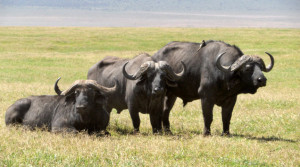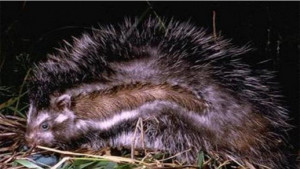Top 5 Bizarre Animal Defense Tactics
You know not to get between a grizzly and her cub, or to corner a raccoon, or scare a skunk, because you’ve heard what will happen if you do (and it’s probably going to be painful…or smelly).
But Tanzanian wildlife have developed some pretty strange defensive moves over time. If you threaten these creatures, they won’t just attack, they’ll:
–
1.) Circle the Wagons–African Buffalo
The African buffalo’s massive size—it can grow up to 2000 pounds!—and the nearly impenetrable bone-shield formed by its fused-base horns are its best defenses against predators (including people; rifle bullets often don’t penetrate the African buffalo’s bony skull). That’s why, when threatened, African buffalo will form a circle around the young, horns out, and essentially dare predators to attack.
Seeing as it often takes multiple predators to bring down even a single adult African buffalo, it’s a fair bet that few animals attempt to break through the buffalo shield-wall.

African Buffalo will protect their young with a circle of horns.
Photo by Thomson Safaris guests Brian & Karen Berkley
2.) Play (Poisonous) Dress Up–African Crested Rat
Müllerian mimicry is an adaptation in which two lethal species mimic the appearance of one another, doubling the chance that predators get the “back off” message. Along with Batesian mimicry—where non-toxic species copy specific markings and colorations of lethal counterparts—it’s usually seen in insects or reptiles, but you rarely find either in mammals.
Except, of course, for the African crested rat, a species that, when threatened, puffs up into a dead-ringer for the crested porcupine (whose danger to predators is obvious).
Predators should take the warning seriously; crested rats often rub their (not-very-pointy) hairs in toxins from the poison-arrow tree, making them an even more dangerous meal than their spiky look-alikes.
 -‘
-‘
Is it a porcupine or a rat?
“Lophiomys imhausi” by Kevin Deacon – Own work. Licensed under CC BY-SA 3.0 via Wikimedia Commons – https://commons.wikimedia.org/wiki/File:Lophiomys_imhausi.jpg#mediaviewer/File:Lophiomys_imhausi.jpg
3.) Learn Karate–Savannah Hare
Rabbits and hares aren’t exactly known for their “fight” response to danger, and like most of its cousins, the savannah hare’s primary defense mechanisms are running away (with as many evasive maneuvers as possible) and cowering in fear, hoping not to be seen. Occasionally, though, a hare will use its long back legs to kick around smaller predators. Maybe it’s not that they can’t fight, it’s that they’ve been trained to use their art only as a last resort…
“Ethiopian Highland Hare (Lepus starcki) in grass” by jtkerb – Ethiopian Highland Hare (Lepus starcki)Uploaded by Richard001. Licensed under CC BY 2.0 via Wikimedia Commons – https://commons.wikimedia.org/wiki/File:Ethiopian_Highland_Hare_(Lepus_starcki)_in_grass.jpg#mediaviewer/File:Ethiopian_Highland_Hare_(Lepus_starcki)_in_grass.jpg
–
4.) Yawn–Hippo
Hippos don’t have to worry too much about predators; they’re massive, they’re armed to (or is it with?) their 6 ½ pound teeth, and they can run at speeds up to 30 miles per hour when aggravated. So oftentimes, rather than engage a threat, hippos simply crack open their jaws—which can extend up to 150°—and flash their serious dental daggers. Unsurprisingly, that’s often enough to neutralize the situation.
You look tired. I’ll just come back never.
Photos by Thomson Safaris guest, Len Kurzweil
–
5.) Armor-Plate Yourself in Razor Blades
One look at a pangolin tells you it plays great defense. Covered in keratin scales, this insectivore’s best tactic is to roll into a ball and simply become impenetrable.
But some predators just won’t take “no way in” for an answer, which is why the pangolin’s scales aren’t just hard, they’re razor-sharp. Controlled with powerful musculature, anything trapped between a pangolin’s scales can be sliced to shreds.
And to add insult to injury, pangolin can emit skunk-like sprays from glands near their tails. Probably it’s just better to stay on these guys’ good side…
.embed-container { position: relative; padding-bottom: 56.25%; height: 0; overflow: hidden; max-width: 100%; } .embed-container iframe, .embed-container object, .embed-container embed { position: absolute; top: 0; left: 0; width: 100%; height: 100%; }



